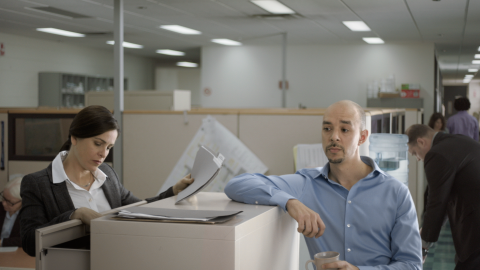
“It shows situations that everyone of us has lived at one moment or another, and through the looping, we just illustrate the bad behavior of what we’ve been doing and magically the loop changes at the end, where we showcase the right way or what we feel would be a better way to deal with it,” Nicolas Dion, creative director of Montreal-based LG2, tells Samaritanmag.
The ad agency created the TV and YouTube looping spots in both English and French. They have been running since just before Christmas and will conclude on Bell Let’s Talk Day, tomorrow (Jan. 28), but will remain online. The campaigns are educational, designed to break the stigma of mental illness.
The jarring 30-second spots catch your attention because you’re frankly not used to seeing the same thing looped over and over. How did the idea come about?
“It’s actually a pretty funny story,” Dion says. “I was looking at one of [soccer legend] Pelé’s greatest moments, which is actually a goal he didn’t score. He goes through the entire team and shoots and the ball ends up being right next to the net. And I was looking at the loop, again and again, and I said, ‘at one point it’s gotta get in, you know?’
“So I thought, ‘Wouldn’t it be fun to see an animated loop just de-loop itself?’ and then I got the brief for Let’s Talk. We were talking about breaking stigma and repeating behaviours so I applied that idea to this brief. So that’s how it came to be.
“I also wanted something that makes you realize how strange some of the behaviour we’re using is; we’re saying stuff like, ‘It’s paid vacation’ or ‘Just walk outside, you’re gonna feel better’ or ‘Just toughen up,’ and nobody tells you that’s wrong,” he adds.
“Nobody talks about these things, mental health, in general, and especially the way people act in their daily lives, so we wanted to show that and show it in a way that stands out from all these messages that we see all the time for good causes, so the format itself needed to be something that people took notice of.”
The commercials had to be looped enough times for the viewer to pay attention and realize that it’s weird that the exact same lines and scenarios are shown three times. Then the fourth time, when the result changes, you get it.
“Yeah, we had this notion, the first time you see it; the second time you’re not sure; the third time you realize something’s wrong and, by the fourth time, you’re almost relieved that it’s something else,” says Dion.
The Bell Let’s Talk program was started by George Cope, president and CEO of Bell Canada and BCE, who in 2010 pledged $50 million through the company to mental health charities over four years. And the commitment continues.
On Jan. 28, for every text message, wireless and long distance call made by Bell Canada and Bell Aliant customers, every tweet using #BellLetsTalk, and every Facebook share of that day’s Bell Let’s Talk Day image at Facebook.com/BellLetsTalk, Bell — Canada’s largest telecommunications company — will donate 5 cents more to Canadian mental health programs.
According to its press materials, in 2014, the public’s response added another $5,472,585,90 to its Bell Let’s Talk funding commitment. With the tally from the last four Bell Let’s Talk Days, Bell has now committed more than $67.5 million to Canadian mental health.
The Bell Let's Talk mental health initiative Bell Let’s Talk promotes mental health based on four action pillars – anti-stigma, care and access, research, and workplace best practices.
STORY CONTINUES AFTER VIDEO:
Dion says LG2 doesn’t work directly with Cope, but deals with Rick Seifeddine, senior vice-president of brand, and Élaine Bissonnette, director of brand strategy, in Bell’s brand office. “They are my links between all the experts,” he says.
“I present to Bell and together we tweak the concept and, this year, we only presented this campaign. Often times we give them choices, but this year we felt this is the strongest thing and they went on board and they helped us after that create the concept.”
Dion says the reaction to the three ads have largely been similar to this reporter.
“The same reaction as you. At first they took notice of the format and then they realized how much the spot affected them and I’ve heard since the beginning of Let’s Talk, they are probably the most successful ones yet from a feedback perspective. Most people are and intrigued and pleased by the subject, of course, but also the way we treat it the looping and the awkwardness you get when you watch.”
He says, “they might come back next year. I don’t know.”
Is it disappointing that such great work and such an important message is only given a six-week run on TV and must be sought out online afterwards?
“No, we decided to go with the more intense month and a half approach,” Dion says. “We beat record after record in the number of interaction and tweets and donations so we feel that having it compressed in a shorter amount of time, somehow you get a bigger splash as opposed to taking the same amount of spots and sprinkle them throughout the year. As long as we’re doing the good work in the time we are doing it, I think that’s the right way to go.”
/Nike_7_1